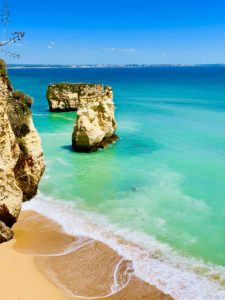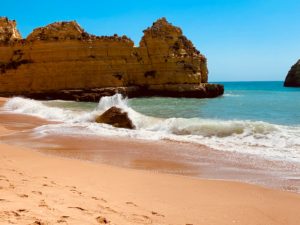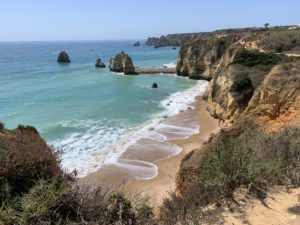Portugal is one of the places that was on our list of possible countries to settle in. After a whirlwind three weeks in the States we arrived in Lagos a bit rundown and it took us a bit longer to bounce back from jet lag than usual. But after a couple of days, we finally emerged to begin exploring Lagos. Our timing was good, as we arrived before the majority of tourist and we were able to explore the city and beaches without the crowds.
Lagos is a quaint town in the Algarve region of Portugal. The “old town” is surrounded by the Lagos 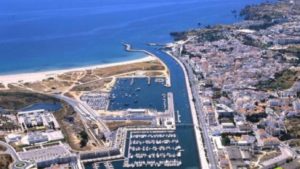 Castle which was built by the Moors in the 8th century. The town itself if divided by a large shipping canal that cuts the area diagonally. Most the residential area, old town, city hall and grotto beaches on are the Northwest side, while the major marina, ship yards and the largest public beach is on the Southeast side.
Castle which was built by the Moors in the 8th century. The town itself if divided by a large shipping canal that cuts the area diagonally. Most the residential area, old town, city hall and grotto beaches on are the Northwest side, while the major marina, ship yards and the largest public beach is on the Southeast side.
Like many sun soaked areas in Europe, the buildings are 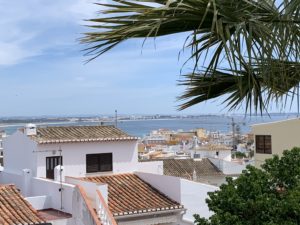 almost all painted bright white with blue or green accents. The local language is Portuguese, and while almost no one speaks Spanish, many can muddle along in English. The distinction between Spanish and Portuguese is important since both Bonnie and I are pretty comfortable in Spanish, but we had each forgotten the Portuguese we learned while living in Brazil. One certainly wants to try and speak the local language, and since they sound similar the inclination is to ‘fake it’ by speaking Spanish. However, with all the similarities, they are different enough to be difficult. Orange juice, for instance in Spanish to jugo de naranja and in Portuguese it is suco a laranja.
almost all painted bright white with blue or green accents. The local language is Portuguese, and while almost no one speaks Spanish, many can muddle along in English. The distinction between Spanish and Portuguese is important since both Bonnie and I are pretty comfortable in Spanish, but we had each forgotten the Portuguese we learned while living in Brazil. One certainly wants to try and speak the local language, and since they sound similar the inclination is to ‘fake it’ by speaking Spanish. However, with all the similarities, they are different enough to be difficult. Orange juice, for instance in Spanish to jugo de naranja and in Portuguese it is suco a laranja.
All roads in Lagos lead downhill to the shopping/entertainment district that is nestled by the 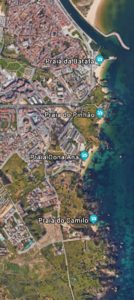 sea. This means there can be some pretty steep walks back up the hills to return from town or the beaches. The town in the old city is what you would expect to find in a European tourist area, jammed with small bars, coffee shops and trinket vendors. Kiosks line the boardwalk along the canal and small restaurants fight for space on the waterfront.
sea. This means there can be some pretty steep walks back up the hills to return from town or the beaches. The town in the old city is what you would expect to find in a European tourist area, jammed with small bars, coffee shops and trinket vendors. Kiosks line the boardwalk along the canal and small restaurants fight for space on the waterfront.
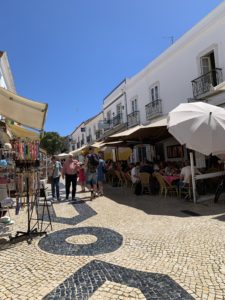 One delightful thing we have found is the quality of the live music presented by buskers in the street. Unlike many areas that shun traveling bards, Lagos encourages it and has it organized. Buskers are required to present their address and a photo once a year, they are also required to go in on Fridays and get a permit for performances the following week. We are told that the enforcement of these requirements for newcomers is pretty loose, and a first time cry of “gosh I didn’t know” will get you a slap on the hand and an explanation of the rules.
One delightful thing we have found is the quality of the live music presented by buskers in the street. Unlike many areas that shun traveling bards, Lagos encourages it and has it organized. Buskers are required to present their address and a photo once a year, they are also required to go in on Fridays and get a permit for performances the following week. We are told that the enforcement of these requirements for newcomers is pretty loose, and a first time cry of “gosh I didn’t know” will get you a slap on the hand and an explanation of the rules.
We previously mentioned the beaches, on the other side of the canal is the the largest and longest which is called Meia Praia (Praia = beach). This white sandy beach runs for miles and is a favorite of the Brits who flock to Lagos in the summer. Along the beach, are several restaurants that offer a cool glass of Vinho Verde (a local style of white wine), excellent food and shade from the sun.
But the real jewels of Lagos are the grotto beaches just down the road from the old town. These 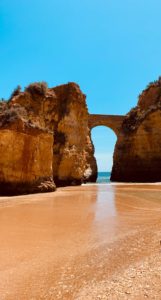 beaches, starting with Batata do Praia (Potato beach) are harder to get to, smaller and surrounded by sheer walls of ancient rock. The waterline of the beach has more shells, stones and rocks than Meia Praia, but the views are amazing, Many of grotto beaches are interconnected by small passage through the stone cliffs.
beaches, starting with Batata do Praia (Potato beach) are harder to get to, smaller and surrounded by sheer walls of ancient rock. The waterline of the beach has more shells, stones and rocks than Meia Praia, but the views are amazing, Many of grotto beaches are interconnected by small passage through the stone cliffs.
